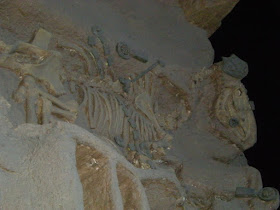That evening we had to go to one of Beijing’s three other train stations. I have never, ever been in a train station that large. It was easily twice the size of DC’s Washington National airport. We boarded our train which was actually headed for Lhasa and managed to squeeze our bags into the tiny train compartment which we shared with a very nice couple from Beijing. The trip was pretty uneventful. Our train didn’t leave until 9:30pm so we went right to sleep.
Once in Xi’an we decided after much deliberation to trust the English speaking guy who wanted to be our driver. Turns out that was the right choice. He ended up not only being very trustworthy and giving us a good deal on being our driver for the day, he took us to a couple cool places we would have otherwise missed.
Our driver first took us to the Banpo village excavation site/museum. The entire way there we thought he was taking us to a bamboo village and so had a moment of “ahhh” when we got there. First discovered in 1953, Banpo contains the remains of several well organised Neolithic settlements dating from approximately 4500 BC. It is a large area of surrounded by a ditch with circular houses built of mud and wood with overhanging thatched roofs. The building they built over the site was pretty cool-lots of big open space showing the excavation with smaller rooms set aside for specific exhibitions. And we had it all to ourselves.
I was less interested in the pots and village models


and far more interested in the communal burial sites and skeletons





Lauren and I had fun pretending that we were Booth and Bones trying to figure out COD (that would be cause of death to those of you who are not, but should be watching Bones).
After Banpo it was off to a factory that made a variety of things including shadow puppets, porceline figurines, laquer furniture, and…all sized models of the Terracotta Warriors. I didn’t take any pics there but these are from Lauren’s collection.


Our next stop was yet another factory-this one devoted to the creation of and production of silk products. This factory actually made the silk then turned it into bedding, wall hangings, clothes, etc. The clothing section was pretty well stocked and prepared for foreigners. Granted I was looking at XXX and XXXX sized clothes…but they fit. According to both our driver and the people at the factory, silk produced in Xi’An is the best as it is 100% silk whereas say Shanghai produced silk is really only 75% and 25% poly-something. Again props to Lauren for these pics.


After shopping at the factory it was finally on to the site of all sites in Xi’An…the Terracotta Army. Dating to 210 BC, the army was built for the tomb of the Emperor Qin so he could continue to fight wars in the afterlife. While endless dynasties have ruled on the Chinese continent, Qin Shi Huang was the first emperor of China. He conquered the princes and kings to unify the country, established one single writing system, built standard roads, and began the Great Wall. He is an emperor of legend and is featured in movies, including Jet Li’s Hero and Chen Kaige’s The Emperor and the Assassin (which is long but a great film). The Army figures vary in height (183–195cm - 6ft–6ft 5in), according to their role, the tallest being the generals. The figures include warriors, chariots, horses, officials, acrobats, strongmen, and musicians. Current estimates are that in the three pits containing the Terracotta Army there were over 8,000 soldiers, 130 chariots with 520 horses and 150 cavalry horses, the majority of which are still buried in the pits. Their bodies were mass produced using wax molds…but each face is individual. Every single man in Qin’s army had to sit for an artist to have his likeness taken, which was then carved into a mold and placed atop the prepared body.
The complex is huge and had it not been cold, grey, and raining, we could have explored more.



Instead we headed straight to the pits (which took us a while to find) to see the main attraction. Our pictures turned out kind of crap though. The high, curved ceilings of the pits are almost completely skylights and that is the majority of the light in each building. On such a cloudy and rainy day as we had it meant that the light was very low and camera flashes were useless.








Despite the disappointment of bad pictures, it was truly an awe inspiring experience. Despite the dozens upon dozens of visitors an almost eerie silence prevailed through the pits as people took in the sight of one man’s devotion to immortality.


No comments:
Post a Comment